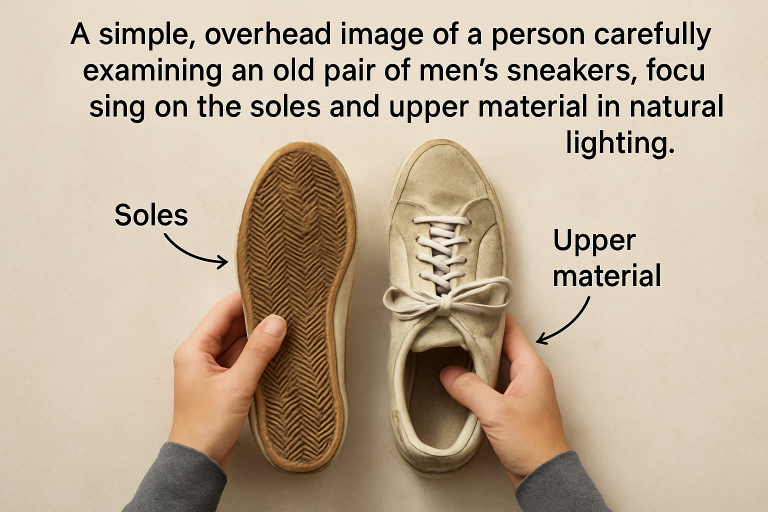Vintage men’s sneakers hold a unique place in modern style, celebrated as historical artifacts and fashion statements. Whether you’re a collector, a reseller, or simply a fan of classic kicks, knowing how to assess the condition of these shoes is crucial to preserving their value and wearability. When building a refined wardrobe inspired by premium taste, such as men’s fashion by Alexander McQueen, understanding the standard for high-quality footwear is essential—including what keeps vintage sneakers functional and visually appealing.
Evaluating a pair of vintage sneakers requires more than a quick glance. Small details can impact comfort, longevity, and desirability for collectors. This guide will walk you through a detailed inspection process, empowering you to make informed decisions about preserving, restoring, or enjoying your favorite pairs for years to come.
1. Examine the Soles for Wear and Tear
The longevity of any sneaker starts at the sole. For vintage pairs, sole examination provides key insight into age and use—critical factors that influence value and safety. Signs to look for include:
- Uneven Wear Patterns: Uneven or pronounced wear can indicate issues with gait or a poor fit when first worn. According to Brit + Co, this can also lead to discomfort if you intend to wear the shoes regularly.
- Thinning or Cracking: Soles should maintain a sturdy profile. Thinning, flaking, or cracks compromise structure and protection.
- Loss of Traction: Without clear tread patterns, the risk of slipping increases dramatically. Brit + Co highlights how diminishing grip can signal time for replacement or restoration.
2. Inspect the Upper Material
The appearance and resilience of the upper—be it leather, suede, canvas, or synthetic—greatly influences a vintage sneaker’s longevity. Focus on:
- Cracks or Tears: Any splits or holes weaken the shoe’s exterior and can worsen with wear. VCleat recommends a close visual and tactile check to catch early signs.
- Loose Stitching: Stitches coming undone may open new holes or risk more rapid upper separation.
- Discoloration or Fading: Natural patina adds subtle charm, but deep fading might be a red flag for advanced deterioration in fabric or leather.
3. Assess the Midsole and Cushioning
Hidden inside the sneaker, the midsole’s job is shock absorption and support. Deterioration isn’t always visible until you look closer:
- Creasing or Wrinkling: These lines suggest the cushioning has compressed and lost resilience. John’s Run/Walk Shop notes that midsole collapse can happen long before a shoe looks visibly damaged from the outside.
- Hardening: If pressing the midsole feels more like tapping wood than foam, it likely won’t offer adequate support or comfort anymore.
4. Check for Odors and Mold
How a shoe smells tells you much about how it was stored. A musty odor usually indicates moisture exposure and possible mold, which can weaken materials and be hazardous to your health. Persistent unpleasant odors may require special cleaning or signal irreparable issues.
5. Evaluate the Laces and Eyelets
Laces and eyelets might seem minor, but vintage collectors often value original finishes and details:
- Fraying or Discoloration: Mild fraying shows age, but deep wear suggests the need for replacement.
- Damaged Eyelets: Rust or warping around the lace holes can make shoes harder to tie securely and are prone to further tearing.
6. Look Inside the Shoe
The interior of the shoe is a strong indicator of overall use:
- Insole Wear: Look for worn-down logo prints or impressions of the previous owner’s foot. These are telltale signs the sneakers saw heavy rotation. UNBOXED explores these details and their implications for value.
- Heel Padding: Missing or compressed heel pads not only reduce comfort for the next wearer but can also hasten further upper wear in the heel area.
7. Test for Flexibility
Vintage sneakers are more susceptible to drying out. Gently bend each shoe at the ball and heel—flexibility is vital. Shoes that resist movement or “crack” audibly may be past their safe-to-wear prime, risking damage if you attempt to use them for walking.
8. Research the Specific Model
Familiarize yourself with the sneaker’s model history, as certain lines are known for problems such as midsole crumbling or separation with age. Some ‘80s and ‘90s sneakers, for example, utilized polyurethane midsoles prone to breaking down. Forums, resellers, or condition reports for similar models will help clarify what’s normal aging versus actual damage for your pair.
9. Conclusion
Being meticulous about inspecting vintage men’s sneakers protects not just your investment, but also your love for timeless design. By taking these practical steps—scrutinizing soles, uppers, interiors, and model-specific concerns—you can confidently judge whether a pair is ready for display, restoration, resale, or even regular wear. With mindful upkeep and a discerning eye, your favorite retro kicks can remain a distinctive, wearable hallmark of style for many years to come.


